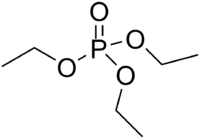Triethyl phosphate
 | |
| Names | |
|---|---|
| IUPAC name
Triethyl phosphate | |
| Other names
Ethyl phosphate; Triethylphosphate; Tris(ethyl) phosphate; Triethoxyphosphine oxide | |
| Identifiers | |
| 78-40-0 | |
| ChEBI | CHEBI:45927 |
| ChemSpider | 6287 |
| DrugBank | DB03347 |
| |
| Jmol-3D images | Image |
| PubChem | 6535 |
| |
| Properties | |
| C6H15O4P | |
| Molar mass | 182.15 g/mol |
| Density | 1.072 g/cm3 |
| Melting point | −56.5 °C (−69.7 °F; 216.7 K) |
| Boiling point | 215 °C (419 °F; 488 K) |
| Miscible | |
| Hazards | |
| NFPA 704 | |
| Flash point | 107 °C (225 °F; 380 K) |
| Except where noted otherwise, data is given for materials in their standard state (at 25 °C (77 °F), 100 kPa) | |
| | |
| Infobox references | |
Triethyl phosphate is a chemical compound with the formula (C2H5)3PO4. It is a colorless liquid. It is the triester of ethanol and phosphoric acid and can be called "phosphoric acid, triethyl ester".
Its primary uses are as an industrial catalyst (in acetic anhydride synthesis), a polymer resin modifier, and a plasticizer (e.g. for unsaturated polyesters). In smaller scale it is used as a solvent for e.g. cellulose acetate, flame retardant, an intermediate for pesticides and other chemicals, stabilizer for peroxides, a strength agent for rubber and plastic including vinyl polymers and unsaturated polyesters, etc.[2]
Triethyl phosphate is also a common intermediate in the manufacture of pesticides.
History
It was studied for the first time by French chemist Jean Louis Lassaigne in the early 19th century.
See also
References
- ↑ "Zhangjiagang Shunchang Chemical Co., Ltd". Triethylphosphate. Retrieved June 13, 2009.
- ↑ Triethylphosphate, International Programme on Chemical Safety
